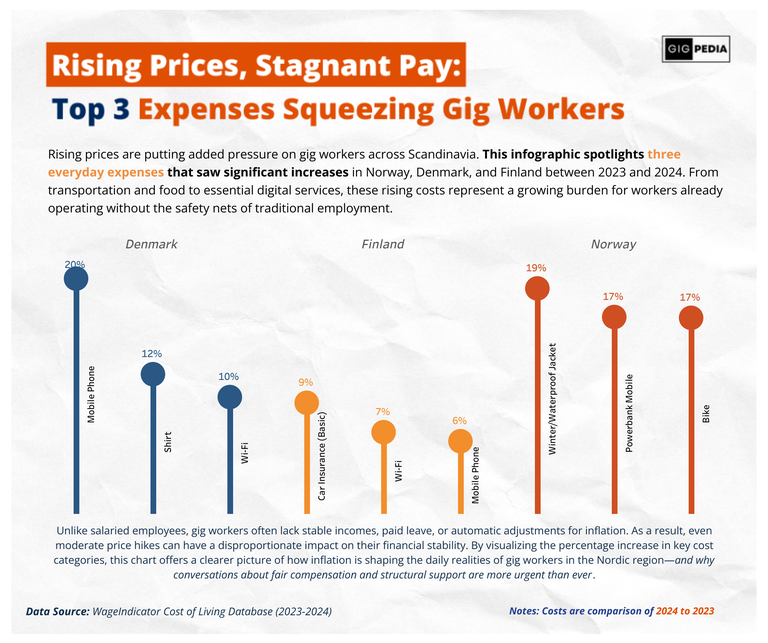
Platform workers, both migrant and non-migrant, often find that platform-mediated gig work provides them with an entry point to the labour market. This is also true in countries such as Norway and Sweden.
Drawing on data collected by WageIndicator, this article examines one of the most common challenges faced by platform workers in the Nordic countries (and around the world): the cost of living and work-related expenses.
Why do platform workers choose this type of work in the Nordic countries?
In countries such as Norway and Sweden, platform-mediated gig work has become a common entry point to the labour market for migrant workers. It has also become a better source of income for local platform workers than they have experienced previously, and is sometimes the only option due to limited employment opportunities.
Many gig workers see this type of work as one of the few accessible opportunities in the labour market, as well as a potential step forward in their careers. Factors such as a lack of direct supervision and flexible working hours can influence job choices.
What disadvantages do platform workers in those countries face as a result of the gig economy?
As is the case in other contexts, platform work has certain advantages, but also imposes significant demands, starting with long working hours. Platform workers remain formally flexible, but in practice they have to work very long hours to earn a living, cover all their expenses, and save something for the future.
As gig platforms have become more prominent in the Nordic countries, research has provided insights into the impact of platform-mediated labour on workers, highlighting issues such as social isolation and a lack of recognition.
However, further research is needed to improve our understanding of the financial challenges they face and where these challenges originate, starting with work-related costs.
How do platform workers deal with work-related costs?
The platforms differ in terms of sector, pay and control mechanisms. Workers enter the gig economy for various reasons, whether for a short or long period. However, they all have one thing in common: the work-related costs they incur.
According to the Living Tariff concept developed by WageIndicator, these usually include:
- Equipment
- Overhead time
- Income taxes
- Social security
- Savings for illness or retirement.
The Living Tariff concept illustrates the various work-related costs faced by platform and gig workers and freelancers, helping them calculate the minimum rate they should charge in order to live decently.
This is an essential factor to consider when analysing their working conditions and what the future may hold for them, particularly in the context of the global cost of living crisis.
| Would you like to explore insights from different countries? Over the past year, we have collected data on price changes in various locations, ranging from Bolivia to Vietnam. |
Which work-related costs have increased the most?
Between 2023 and 2024, platform workers in Denmark found that the cost of buying a mobile phone had increased by 20%. Another essential for remote freelancers — Wi-Fi — also increased in price by 10%. Clothing, particularly shirts, saw a 12% price increase.
Similar findings have been reported in Finland, where platform workers' finances come under the most pressure from three main expenses: Wi-Fi (7%) and mobile phones (6%), with basic car insurance (9%) added to these.
However, the largest price increases were seen in Norway.
- There was a +17% increase in the price of bikes used by delivery services.
- Power banks, which are necessary for recharging and staying connected during long work shifts, increased by 17%.
- Winter and waterproof jackets, which are helpful in the coldest season, increased by 19%.

Why is it important to investigate work-related costs?
Examining the work-related costs faced by platform workers in the Nordic countries reveals that rising prices are putting pressure on them.
WageIndicator's quarterly data collection shows that large and unexpected price increases are a particular issue for gig workers globally. They rely on an unstable income, cannot benefit from inflation-related adjustments, and lack a safety net.
Such insights are also valuable when discussing another common issue in the platform economy: the effect of unpaid work on workers' earnings.
This topic was explored in the WageIndicator survey on the platform economy and unpaid work, conducted in partnership with KU Leuven and the ResPecTMe project. The survey investigates the scope and impact of unpaid work among platform workers, including hidden costs such as paying for equipment maintenance, buying safety gear, and other work-related expenses (e.g. phone, internet, clothing). These hidden costs can result in a wage penalty.
If you are a platform worker, you can complete a survey about unpaid work and the platform economy on Gigpedia.
You can read the codebook to find out more about the survey itself, including the topics covered, its aims and its scope.
